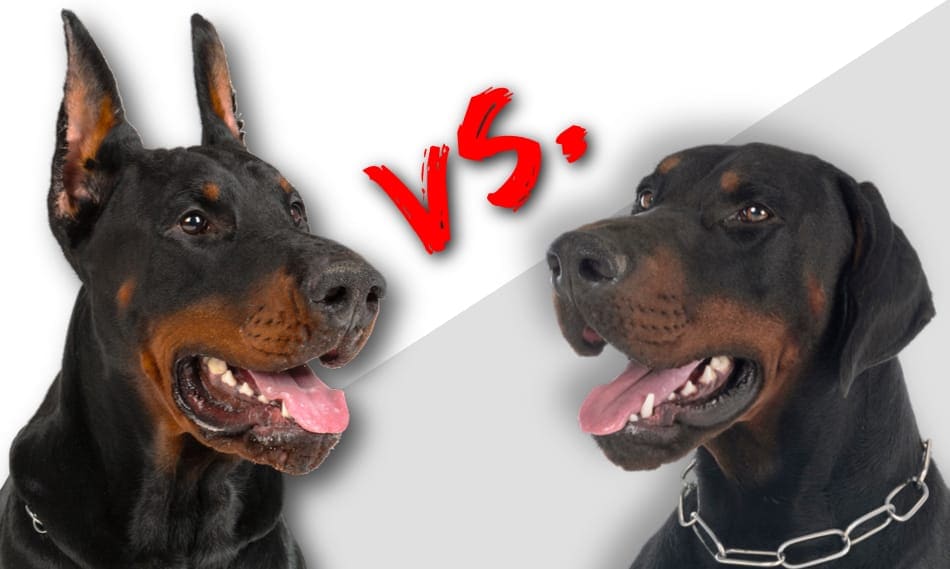Have you ever wondered how they crop Doberman ears? This common practice in the Doberman Pinscher breed involves surgically altering the shape of the dog’s ears. It is a controversial topic, with opinions varying among dog owners and veterinarians. Let’s explore the process and learn more about the reasons behind this procedure.
The cropping of Doberman ears has its roots in historical and practical reasons. Originally, the procedure was done to prevent injury and enhance the Doberman’s ability to perform its working duties. The upright, cropped ears were believed to improve hearing, while the erect stance added to the breed’s intimidating appearance. Today, the decision to crop ears is often based on breed standards for dog shows, as well as personal preferences of Doberman owners. It’s important to note that ear cropping is controversial, and many countries have banned or restricted the procedure due to concerns about animal welfare.
To crop Doberman ears, it’s best to consult a professional veterinarian or experienced breeder. They will ensure the process is done safely and correctly. The ears are carefully trimmed and shaped while the pup is under anesthesia. Some breeders prefer a longer crop, while others prefer a shorter crop. The procedure itself involves careful monitoring and aftercare to ensure proper healing. It’s important to remember that ear cropping is a personal choice and not necessary for the dog’s well-being.

How Do They Crop Doberman Ears?
Doberman ears are known for their distinctive look, often cropped to stand erect. But have you ever wondered how they crop Doberman ears? In this article, we will explore the process of cropping Doberman ears, the reasons behind it, and the considerations involved.
1. What Is Ear Cropping?
Ear cropping is a surgical procedure that involves removing a portion of a dog’s external ear, followed by a strategic taping and bandaging process that encourages the ears to stand upright. It is a cosmetic procedure commonly performed on certain breeds, including Doberman Pinschers, for aesthetic purposes.
The purpose of cropping the Doberman’s ears is to achieve the breed’s signature look, with ears that stand erect and point forward. The cropped ears enhance the Doberman’s alert expression and give them an imposing and confident appearance.
It’s important to note that ear cropping is a controversial topic, and opinions on the subject vary. Some people believe that ear cropping is unnecessary and can cause pain and discomfort for the dog. Others argue that it is a breed standard and part of preserving the Doberman’s identity.
2. The Process of Cropping Doberman Ears
The process of cropping Doberman ears typically involves the following steps:
- Sedation or anesthesia: The dog is sedated or anesthetized to ensure a calm and pain-free experience during the procedure.
- Evaluation and measurement: The veterinarian will evaluate the dog’s ears to determine the appropriate length and shape for cropping. Measurements are taken to ensure symmetry.
- Marking the incision lines: The veterinarian will mark the desired incision lines on the dog’s ears using a surgical pen.
- Surgical procedure: The excess ear tissue is removed along the marked lines using sharp surgical instruments. The edges of the incisions are sutured to promote healing.
- Taping and bandaging: The ears are taped and bandaged in a way that encourages them to stand upright. This process involves wrapping the ears with a supportive material and securing them with adhesive tape.
- Post-operative care: It is crucial to follow the veterinarian’s instructions for post-operative care, including cleaning the ears, administering medication, and keeping the dog’s activity level restricted during the healing process.
3. Considerations for Ear Cropping
Before deciding to crop a Doberman’s ears, there are several important considerations to keep in mind:
- Legal restrictions: Ear cropping is banned or restricted in some countries and regions. It is essential to be aware of the laws and regulations regarding ear cropping in your location.
- Breed standards: Ear cropping is often associated with breed standards and conformation shows. If you are planning to show your Doberman, cropped ears may be necessary to meet the breed standard.
- Health risks and complications: Like any surgical procedure, ear cropping carries risks, including infection, bleeding, and adverse reactions to anesthesia. It is crucial to discuss these risks with a qualified veterinarian.
- Personal preference: Ultimately, the decision to crop a Doberman’s ears is a personal choice. It is important to consider your preferences and weigh them against the potential risks and the dog’s comfort.
4. Aftercare and Healing Process
The healing process after ear cropping typically takes several weeks. During this time, the dog’s ears need to be regularly cleaned to prevent infection. The bandages and tapes need to be changed as instructed by the veterinarian. It’s crucial to monitor the dog for any signs of complications or discomfort and seek veterinary care if necessary.
It’s important to note that the ears may not stand upright immediately after the surgery. It takes time for the cartilage to harden and the ears to heal properly. With proper aftercare and taping, the ears should eventually stand erect.
Are Cropped Ears Right for Your Doberman?
When deciding whether to crop your Doberman’s ears, it’s essential to consider all the factors mentioned above. Carefully weigh the breed standards, legal restrictions, health risks, and personal preferences before making a decision.
Many Doberman owners choose not to crop their dog’s ears, as they believe in preserving the natural appearance and avoiding potential risks. Ultimately, the choice is yours to make, and it should be based on what is best for your Doberman’s well-being and your personal preferences.
Key Takeaways: How Do They Crop Doberman Ears?
- Ear cropping is a surgical procedure done to shape the Doberman’s ears.
- The procedure is usually performed when the puppy is between 8 and 12 weeks old.
- Veterinarians use surgical techniques to remove a portion of the ear, then bandage and tape the remaining ear to encourage it to stand upright.
- The procedure is controversial and banned in some countries due to concerns about animal welfare.
- Owners should carefully consider the risks and benefits before deciding to crop their Doberman’s ears.
Frequently Asked Questions
Here are some common questions related to cropping Doberman ears:
1. Why do people crop Doberman ears?
Cropping Doberman ears is a practice that has been around for many years. The main reason why people choose to crop their Doberman’s ears is for cosmetic purposes. Cropped ears give the breed a more alert and assertive appearance, which is highly characteristic of the Doberman Pinscher. Additionally, some owners believe that cropped ears can help prevent ear infections, although there is no scientific evidence to support this claim.
It is important to note that ear cropping is a personal decision, and opinions on the subject can vary. Some people choose not to crop their Doberman’s ears for ethical reasons or simply because they prefer the natural look. Ultimately, the decision should be made in consultation with a reputable veterinarian who can provide guidance based on the individual dog’s health and well-being.
2. What is the process of cropping Doberman ears?
The process of cropping Doberman ears should always be performed by a qualified and experienced veterinarian. It is typically done when the puppy is between 8 and 12 weeks old. The procedure involves surgically removing a portion of the dog’s ears and then stitching them to create the desired upright and pointed shape. The surgery is performed under general anesthesia to ensure the dog’s comfort and safety.
After the surgery, the ears are typically bandaged to protect them and promote proper healing. The puppy will need to wear an Elizabethan collar to prevent them from scratching or damaging the ears during the healing process. Regular visits to the vet will be necessary to monitor the healing progress and remove the stitches when it is appropriate.
3. Does ear cropping cause pain or distress to the dog?
As with any surgical procedure, ear cropping can cause some discomfort and pain for the dog. However, steps are taken to minimize this as much as possible. The surgery is performed under general anesthesia, which ensures that the dog is unconscious and does not experience pain during the procedure.
After the surgery, the dog may experience some post-operative pain, swelling, and discomfort. Pain medication may be prescribed by the veterinarian to manage any discomfort. It is essential for the owner to follow all post-operative care instructions provided by the veterinarian to ensure the dog’s well-being and promote proper healing.
4. What are the risks and complications associated with ear cropping?
Ear cropping, like any surgical procedure, carries some risks and potential complications. These can include:
– Infection: If the surgical site becomes infected, it can delay the healing process and may require additional treatment.
– Excessive scarring: In some cases, excessive scarring can occur, which may affect the appearance of the cropped ears.
– Poor healing: The ears may not heal properly, leading to deformities or the need for additional surgical correction.
– Changes in ear shape or position: Sometimes, the desired shape or position of the ears may not be achieved, requiring further adjustments.
It is essential to choose a skilled and experienced veterinarian who can minimize the risks and complications associated with ear cropping. Additionally, following all post-operative care instructions provided by the veterinarian is crucial to ensure proper healing and reduce the chances of complications.
5. Is ear cropping legal?
The legality of ear cropping varies by country and even by state or province within a country. In some places, ear cropping is considered a cosmetic procedure and is legal. However, in other regions, it may be deemed cruel, unnecessary, or even illegal.
Before considering ear cropping, it is important to research and understand the laws and regulations in your specific location. Additionally, it is essential to consult with a reputable and knowledgeable veterinarian who can provide guidance and ensure that any procedures performed are in compliance with local laws and regulations.

In summary, the process of cropping Doberman ears is typically done when the puppies are between 7 to 12 weeks old. It is recommended to have a professional veterinarian perform the procedure under general anesthesia.
The ears are usually cropped to achieve a certain look and shape, which is commonly seen in show dogs. The procedure involves removing a portion of the ear flap and shaping it to stand erect. After the surgery, the ears need to be regularly cleaned, bandaged, and monitored for proper healing.
